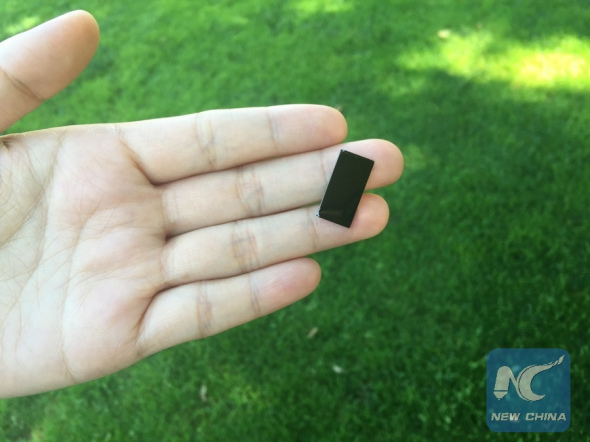
This nanostructured device, about half the size of a postage stamp, uses solar energy to quickly disinfect water. (courtesy of Stanford)
Researchers at the U.S. Department of Energy's SLAC National Accelerator Laboratory and Stanford University have created a nanostructured device, about half the size of a postage stamp that disinfects water with solar energy.
As sunlight falls on the device, it triggers the formation of hydrogen peroxide and other disinfecting chemicals that kill more than 99.999 percent of bacteria in just 20 minutes, much faster than putting germy water out in the sun in a plastic bottle for six to 48 hours to allow ultraviolet rays to kill the microbes.
"Our device looks like a little rectangle of black glass. We just dropped it into the water and put everything under the sun, and the sun did all the work," said Chong Liu, lead author of a report published on Monday in Nature Nanotechnology.
Under an electron microscope, the surface of the device looks like a fingerprint, with many closely spaced lines. Those lines are very thin films, or "nanoflakes" of molybdenum disulfide that are stacked on edge, like the walls of a labyrinth, atop a rectangle of glass.
Molybdenum disulfide, which is cheap and easy to make and is normally used as an industrial lubricant, takes on entirely different properties when made in layers just a few atoms thick.
In the SLAC/Stanford experiments, molybdenum disulfide becomes a photocatalyst: when hit by incoming light, many of its electrons leave their usual places, and both the electrons and the "holes" they leave behind are eager to take part in chemical reactions.
By making molybdenum disulfide walls in just the right thickness, the researchers got them to absorb the full range of visible sunlight. And by topping each tiny wall with a thin layer of copper, which also acts as a catalyst, they were able to use that sunlight to trigger exactly the reactions they wanted.
In this case, the reactions are to produce "reactive oxygen species" like hydrogen peroxide, a commonly used disinfectant, which kill bacteria in the surrounding water.
However, the method does not remove chemical pollutants from water, according to a news release from Stanford.
Although there is no reason to think it would not kill other bacterial strains and other types of microbes, such as viruses, so far it has been tested on only three strains of bacteria, and on specific concentrations of bacteria mixed with less than an ounce of water in the laboratory, not on the complex stews of contaminants found in the real world.
Still, "it's very exciting to see that by just designing a material you can achieve a good performance," Liu said. "It really works."


















































